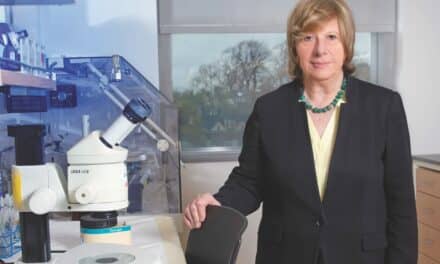 |
Once on the fringes of sleep medicine, light therapy and light therapy products are increasingly being utilized and integrated into sleep practices for treating various circadian rhythm disorders and insomnia conditions. Light therapy products have also developed over the years, becoming smaller and more portable, and integrating specific spectrums of light.
For this month’s Market Trends, Sleep Review interviewed three noted sleep professionals who regularly treat patients with light therapy. We asked them to discuss their utilization of light therapy, and how they implement the therapy and products into their treatment and sleep practices.
Helene A. Emsellem, MD, is director of the Center for Sleep & Wake Disorders, Chevy Chase, Md, and associate clinical professor of neurology at George Washington University Medical Center. She is also the author of Snooze…or Lose! Ten “No-War” Ways to Improve Your Teen’s Sleep Habits. Joseph M. Ojile, MD, FCCP, DABSM, is CEO and founder, Clayton Sleep Institute, St Louis, and The Insomnia Center at Clayton Sleep Institute. He is also associate professor of medicine in Saint Louis University’s Department of Internal Medicine, Division of Pulmonary Medicine, and is the author and coauthor of numerous courses, presentations, and scholarly journal articles in the field of insomnia. Art Spielman, PhD, is associate director at the Center for Sleep Medicine, Department of Neurology, at New York Presbyterian Hospital-Weill Cornell Medical College, New York. He is also the coauthor of The Insomnia Answer, A Personalized Program for Identifying and Overcoming the Three Types of Insomnia.
SR: There are many light therapy products on the market today. What kind of features do you look for in a light therapy product for your patients?
Emsellem: We have found that the light visors are more flexible for people, because they’re not pinned to sitting down in front of light to get their treatment. [The visors] particularly work well for those who have delayed sleep phase syndrome and for people who have to reinforce a morning wake-up time. Time is precious in the morning, so we like things to be as efficient as possible. The light visors allow a level of freedom that the older style light boxes did not. So, we tend to use quite a few visors when related to light situations.
Generally, we’re looking for a product that is going to deliver between 8,000 and 12,000 lux of light. We’d also like it to be visually attractive so that someone can put it on their desk or kitchen table. With a visor, it should be comfortable. Some of these new [products] can be velcroed into the visors that they come with, or you can put one in your very own baseball cap. So, there’s a level of flexibility with them, and we also like that they hold their charge, because then you’re not connected to an outlet to get your light treatment. That makes a huge difference in terms of compliance and the treatment regimen.
 |
| Art Spielman, PhD |
Ojile: We’re big advocates of light therapy and the right therapy, but we typically try to do it without boxes if we can, or we give patients the brochures on different suppliers and have them go rent the boxes for a period of time.
I prefer [light therapy products] to be very portable, such as light visors. We tell our patients to look at those or to get the boxes that they can rent for a month or two and that sit on a table and can be put away.
I don’t have an opinion about blue light or any particular light. For my use, clinically, my patients do fine the way we’re prescribing it.
Spielman: Most of the products that are put out with 5,000 or 10,000 lux of light are effective. I avoid the products that are like desk lamps that reflect the light off of a space. I don’t think that, in my hands, they’ve been as effective. I certainly prefer blue light.
With the devices that put out the blue spectrum, patients can get the effects in about half of the duration of exposure time. That’s efficient, and the blue emitting light sources are even the smallest of all the devices, so they hide away quite easily.
We have some concern with people who’ve had cataract surgery, because there’s a reduced capacity to filter out some of the dangerous wavelengths, so I actually avoid using the blue light [products] in those patients.
SR: In general, how have you implemented light therapy in your practice?
Emsellem: We’ve used [light therapy] primarily for the management of those patients with delayed sleep phase syndrome, including adolescents and adult night owls, and occasionally in the rare patient with an advanced sleep phase syndrome. We’ve found that the combination of the behavioral treatment, light, and melatonin is more successful than the use of any one of these therapies alone.
 |
| Joseph M. Ojile, MD, FCCP, DABSM |
Ojile: A lot of it depends on the reason they have to shift. What I typically do is try to move people about a half hour every so many days. Otherwise, if you have someone who’s getting up at noon and you tell them to get up and do light therapy at 8 in the morning, that’s a tough deal.
If we do identify that people have a circadian rhythm problem, we educate them on how to do light therapy and when to do it, because you can actually cause a bigger problem if you don’t instruct people on how to do the therapy correctly.
Spielman: We use blue light first thing in the morning when they get up. We don’t allow them to use it if they get up a couple of hours before their usual bedtime. We don’t want to be on the wrong side of the phase response curve. But too early can be a problem.
Certainly, when they’re waking up at 10 or 11, then within a few minutes of them getting up, we have them sitting in front of the light. With the blue light, I find that 15 minutes is satisfactory. However, I also combine this with an earlier morning awakening. So, over the course of a week, I’ll have them get up a half hour to an hour earlier.
In addition, I also use light in conjunction with melatonin in the evening, 1-2 milligrams, 4 to 5 hours before their typical sleep onset time. So, if we had that patient who is getting up at 10 and not going to sleep until 3:30 in the morning, I’d have them use melatonin, 1 or 2 milligrams, at 11 to 11:30.
SR: What would you say is the biggest misconception about light therapy among sleep professionals?
| For more about specific light therapy products, visit Sleep Review’s Online 2008 Buyer’s Guide. |
Emsellem: Perhaps that light alone can fix the problem. I think that there are huge behavioral issues underlying many of these sleep disorders, and if you don’t address the sleep-wake behaviors and the other forces driving the problem, then you can’t really successfully treat it. It takes a lot of perseverance to manage a circadian rhythm sleep disorder, both on the part of the patient, who really has to be motivated, and on the part of the treating physician.
The other thing that we’ve found is that seeing the patient and going through the whole routine, outlining the whole treatment plan, and then seeing them in 6 weeks, is not as effective as shorter intervals. In the last couple of years, we’ve found that this group of patients with these disorders requires close follow-up and coaching in order to successfully manage the problem. So, long intervals between visits really don’t work well. We have patients who keep logs for 2 weeks, then come back in, and we often find that they’re doing two of the three things that we recommended, but forgot one of the others. So, if you left out light for 6 weeks, then you’ve got a frustrated patient who didn’t get anywhere, and you’re frustrated that they didn’t do what you asked. With shorter intervals, we pick up on the parts that didn’t get through the first time.
Ojile: The only misconception I would say, if any, is that it’s one of those interventions that isn’t as well appreciated at how effective it can be in helping patients—if you want to call that a misconception. The other misconception is that it may be difficult to implement.
SR: In the last several years, have you seen an increase in the use of light therapy in your practice? Why?
 |
| Helene A. Emsellem, MD |
Emsellem: I’ve written a book about adolescent sleep, and so I get referred quite a few adolescents who have trouble with sleep. So, we seem to have a referral pipeline of an unending supply of sleepy adolescents coming in, and probably about the same number of adults as we’ve always had. But I have to say that I’m more enthusiastic about using light since the visors and smaller devices have become available [because it’s very hard to take someone who can’t get up in the morning and tell them to get up earlier and tell them to sit in front of a light]. The older devices made treatment very difficult for people to comply with, but now compliance is much better with these newer devices.
Ojile: Patients are finally becoming aware that circadian rhythms are an issue. A lot of patients generally know that there’s something called “circadian rhythm,” but they don’t truly understand it. So what’s happening is that we’re seeing increasing referrals for either “not being able to sleep” and insomnia, when what they really have is circadian rhythm [disorders], or they have shift-work issues that have caused circadian rhythm [disorders]. So, people are having an increasing utilization of alcohol to sleep, or they’re having life disruption with relationships, and interpersonal issues, or they’re having trouble at a new job. Those are the big things that are getting people to come in. So the answer is that we are seeing it more, but to me it’s always intriguing why they come in.
Spielman: Not really. I cowrote a book on insomnia, and we talked about how [light therapy] is not being used as much as it should be because, as we say, we don’t need to give the diagnosis of a circadian rhythm disturbance. We think it’s helpful for many cases who have sleep onset problems. I also use it in some cases for people who have early morning awakening, and there’s varied success with that. The light, of course, is used in the evening for those cases. I also have people using blue blocker glasses in the evening, if they have delayed sleep phase syndrome, and I have them wear them at least 2 hours before their bedtime.
Interviewed by Tor Valenza, staff writer for Sleep Review. Tor Valenza can be reached at .





